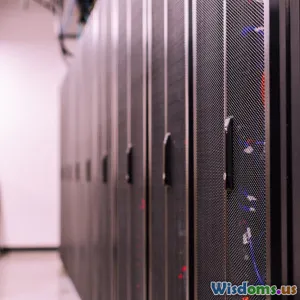
Personal Experience Migrating Legacy Systems to PKI Solutions
8 min read An insightful journey through migrating legacy systems to modern PKI solutions, revealing practical challenges, strategies, and lessons learned to safeguard your digital infrastructure. (0 Reviews)
Personal Experience Migrating Legacy Systems to PKI Solutions
In today's digital era, securing legacy systems is crucial but often overlooked due to their aging infrastructure and complexity. When our company embarked on migrating a decade-old, heterogeneous legacy system to a modern Public Key Infrastructure (PKI) solution, we encountered both significant challenges and transformative learnings. This article plasmidly chronicles that journey to inform, guide, and inspire IT professionals facing similar modernization demands.
Introduction
Legacy systems form the backbone of many enterprises, encompassing critical workflows and sensitive data. Yet, their archaic security measures and dependence on outdated encryption techniques expose organizations to escalating cyber threats. PKI, offering authenticated digital identities, encryption, and non-repudiation, stands as a robust alternative, but migration is rarely straightforward.
Our challenge was migrating an extensive legacy application landscape—with components spanning mainframes, Windows servers, and bespoke applications—toward a centralized PKI system. The goal was bolstering security without disrupting ongoing business.
Understanding the Legacy Landscape
1. Diverse Technology Ecosystem
Our legacy infrastructure was a mosaic:
- Mainframes managing batch processes with proprietary authentication.
- Windows Active Directory domains lacking certificate-based authentication.
- Custom applications developed over years using hard-coded keys.
Legacy codebases were poorly documented, complicating impact analysis.
2. Security Risks and Limitations
Several practices raised red flags:
- Static passwords transmitted over vulnerable channels.
- Obsolete symmetric algorithms like DES and weak key rotations.
- Lack of user or device authentication on critical transactions.
A security audit revealed gaps that, if unaddressed, could risk compliance violations (e.g., GDPR) and potential breaches.
Why Choose PKI?
PKI provides digitally signed certificates, enabling:
- Authentication: Verifying user and device identity through certificates rather than passwords.
- Encryption: Ensuring confidential communication.
- Integrity: Guaranteeing message and data authenticity.
Given the legacy ecosystem's diversity, a centralized PKI offered unified trust anchoring, easing management and audit.
Planning the Migration
1. Stakeholder Alignment
Successful migration begins with multidisciplinary buy-in. We organized workshops involving:
- Security teams explaining PKI benefits.
- Application owners outlining legacy constraints.
- Compliance officers addressing regulatory boundaries.
- Network engineers discussing deployment impacts.
Collective understanding shaped realistic timelines and expectations.
2. Inventory and Assessment
We cataloged systems according to:
- Compatibility with PKI components (e.g., certificate authorities (CAs), hardware security modules).
- Upgrade requirements.
- Criticality of services.
Systems with strict uptime mandates were earmarked for phased deployment.
3. Risk Management
Potential risks included:
- Application downtime.
- Loss of data integrity during transition.
- User resistance to new authentication flows.
Mitigation strategies incorporated fallback mechanisms, thorough testing environments, and detailed communication plans.
Implementation: Step by Step
1. Establishing the PKI Infrastructure
We deployed a hierarchical PKI model:
- Offline root CA to minimize exposure.
- Issuing CAs for different departments.
- Integration with Hardware Security Modules (HSMs) to protect private keys.
Key rotation policies and certificate lifecycles were defined aligning with industry best practices.
2. Pilot Programs
Pilots were limited to less critical systems to:
- Test certificate enrollment and issuance workflows.
- Measure application compatibility.
- Refine user experience with new authentication modalities.
User feedback in this phase identified usability bottlenecks and certificate renewal workflows critical for scalability.
3. Application Refactoring
Legacy applications required updates to:
- Support certificate-based authentication via TLS mutual authentication or signing.
- Replacing deprecated cryptographic libraries with industry-standard implementations (e.g., OpenSSL, Microsoft CryptoAPI).
For example, our mainframe batch processes were adapted to read PKI tokens from secure hardware devices instead of relying on static keys, reducing insider threat risk significantly.
4. Integration with Directory Services
Active Directory (AD) was extended to manage and distribute user certificates effectively. Automated enrollment protocols like SCEP and EST facilitated smooth certificate lifecycle management.
This integration allowed seamless single sign-on (SSO) scenarios enhancing user acceptance.
5. Training and Support
Technical staff underwent intensive training on PKI concepts and management. End-users received targeted communication addressing the benefits and changes they would experience.
A dedicated support desk handled enrollment issues, expediting resolution and minimizing disruptions.
Challenges Faced
Legacy Compatibility Issues
Several applications lacked flexibility to accept certificate credentials, necessitating costly code rewrites or middleware wrappers.
Organizational Resistance
Resistance stemmed from fear of complexity and change in user routines. Transparent communication and demonstrable improvements facilitated gradual adoption.
Operational Complexity
Operating a PKI infrastructure introduced new complexities—certificate lifecycle management, revocation lists (CRLs), and ensuring uptime for CA services stretched team capabilities.
We automated CRL distribution and deployed monitoring solutions to address operational overhead.
Key Lessons Learned
Early and Continuous Communication Is Essential
From stakeholders to users, keeping channels open reduced uncertainty and built trust.
Start Small, Scale Gradually
Phased rollouts controlled risk and allowed iterative improvements.
Invest in Automation
Manual PKI tasks are error-prone and impractical at enterprise scale. Automating certificate issuance and renewal was pivotal for sustainability.
Don’t Underestimate Training
An informed team can prevent misconfigurations that compromise security.
Document Thoroughly
Detailed documentation of PKI deployment and integrations eased troubleshooting and future audits.
Outcome and Impact
After a year, the migration:
- Reduced password-based vulnerabilities by over 75%, verified via penetration tests.
- Improved audit compliance, evidenced by a clean pass in GDPR and ISO 27001 reviews.
- Enhanced user authentication experience with reduced login failures by 40%.
- Increased overall system reliability by centralizing trust management.
Conclusion
Migrating legacy systems to PKI is a formidable yet rewarding endeavor. Our experience underscores the importance of meticulous planning, stakeholder engagement, and embracing automation. PKI's security and scalability benefits justify the upfront investment and challenges.
For enterprises grappling with aging infrastructures, PKI migration is a strategic imperative to future-proof security and compliance. Let this journey illuminate your path, and may your transition be smooth, secure, and successful.
References & Further Reading:
- "PKI for Dummies," T. R. Hardy, Wiley Publishing
- NIST Special Publication 800-32: Introduction to Public Key Technology and the Federal PKI Infrastructure
- "Migrating Enterprise Applications to PKI-based Authentication," Journal of Cybersecurity, 2021
Author's Note: This article reflects real-world migration insights accumulated over two years of hands-on implementation within a multinational organization managing complex legacy systems.
Rate the Post
User Reviews
Popular Posts




















